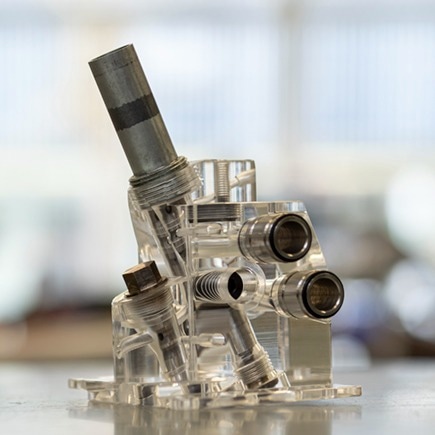Industrial waste heat is a hidden resource because, despite being produced in vast amounts, it is rarely put to good use. This could change, thanks to a new machine type created by Empa Scientists and its collaborators based on cutting-edge engine technology.
 Prototype of the valve actuator, the core of etavalve's piston machine. Image Credit: Empa
Prototype of the valve actuator, the core of etavalve's piston machine. Image Credit: Empa
Andyn Omanovic, a neo-entrepreneur and researcher at Empa, recently received an Empa Entrepreneur Fellowship.
Sometimes, clever concepts take unexpected turns. Engineers at Empa have been developing a novel valve control system for combustion engines with electro-hydraulically actuated valves for years. This method allows far more flexibility in the gas change than is available with traditional camshaft technology.
In a normal passenger vehicle operating mode, fuel consumption in a gasoline engine might be lowered by about 20%. Together with a truck manufacturer, this method is currently being further explored for fuel-flexible engines in cargo vehicles.
However, advancements in another field may suddenly be made possible by this technology. Andyn Omanovic, a former doctorate student at Empa, has been granted an Entrepreneur Fellowship to commercialize a novel design of a piston machine equipped with this control system.
etavalve GmbH, a spin-off of Empa and ETH Zurich, which was co-founded by hydraulics specialist Wolfgang Schneider, engaged in the technology's development, will manage commercialization.
The concept behind the aforementioned piston machine is to make better use of waste heat from processes in the metal or cement sector and other fields by using it more efficiently than with existing turbine-based solutions. According to Omanovic, because the cylinder and piston form a closed space, the process's compression and expansion occur almost perfectly, resulting in an incredibly high energy yield.
The waste heat is transformed into mechanical power by the pistons, which is then used to produce electricity. However, the creative flexible control of the valves is the only reason this procedure can be used at all.
Turbines are particularly effective at high temperatures and for power requirements of several hundred megawatts, but our piston machine is better suited for temperature ranges of around 500º to 900º, where the waste heat is generated irregularly, and up to the power range of several megawatts.
Andyn Omanovic, Material Science and Technology, Empa
There is a lot of potential. In Germany, the annual amount of industrial waste heat over 300º was projected to be approximately 10 TWh in 2016. In contrast, the Association of Swiss Electricity Companies (VSE) reports that Switzerland used about 57 TWh of electricity last year.
Using Climate-Friendly Biochar Plants
Additionally promising is waste heat from pyrolysis plants, which turns biomass into biochar to permanently bind carbon. Empa researchers are working on this method. Lean gas, a byproduct of this operation that contains gaseous contaminants and methane, needs to be burned in accordance with legal requirements.
Omanovic said, “This is often done with a gas flare without any utilization of the energy, and we use this heat to generate electricity with our piston machine.”
Before the Step Into Practice
The development of biochar plants in Switzerland is being driven by the goal of building a pilot machine for the energy supplier IWB in Basel by the beginning of 2025. This machine is specifically intended to meet the needs of the waste heat generated during pyrolysis.
A limited series of piston machines should be delivered to a business that specializes in plants for the combustion of lean gases from landfills or biogas processing around a year later, according to the developers at etavalve. Discussions have already started.
The manufacturing and operation of our very first pilot machine almost covers its costs, which is by no means a matter of course for an innovative technology in complex mechanical engineering.
Andyn Omanovic, Material Science and Technology, Empa
Therefore, despite difficulties with technical details like temperature-resistant machine materials and the control strategy for the thermodynamic process that still need to be mastered, the experts at etavalve are optimistic that their technology could reach the market in the near future. However, cost-benefit analysis is also quite encouraging.